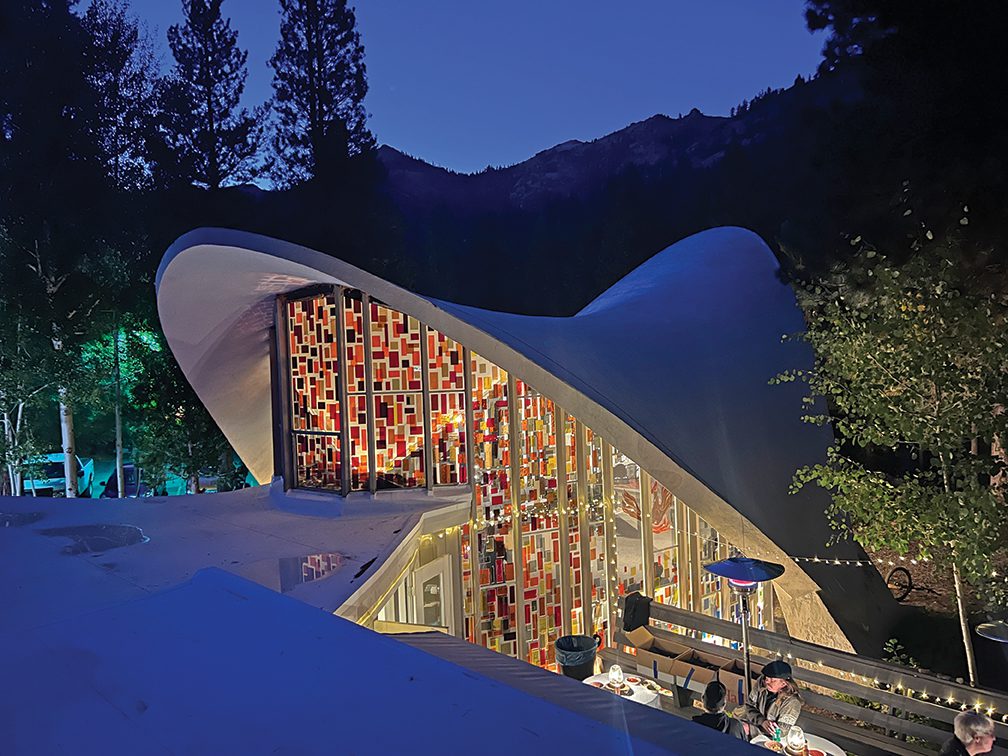
27 Sep An Ancient Art in Modern Times
Local artists continue the age-old tradition of stained glass
Artist JoAnne Barbiaux Pohler is modest for someone with her pedigree.
Although Pohler stepped away from her longtime Truckee business, JoAnne’s Stained Glass, in 2022, her work continues to illuminate people’s lives and living spaces across the United States—from Hawaii to Florida to Lake Tahoe.
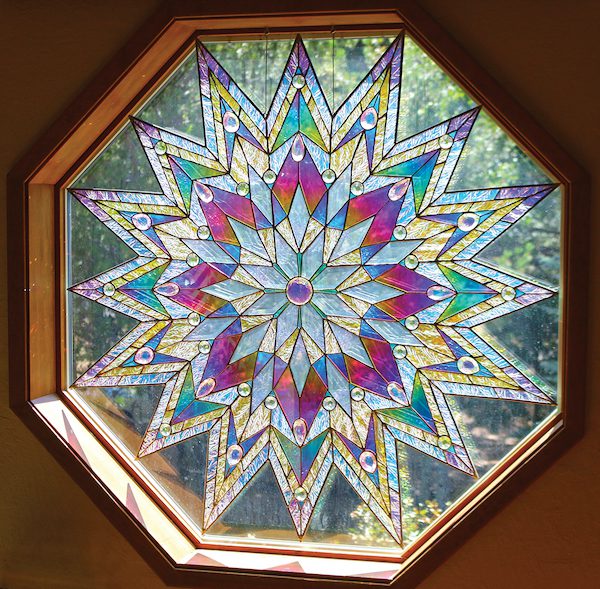
A stained glass window by JoAnne Barbiaux Pohler resides in the bedroom of her Truckee home, photo by Sylas Wright
In fact, over the years, Pohler’s striking designs have caught the eyes of numerous clients of sports and entertainment fame, including Mike Love of the Beach Boys, rapper MC Hammer and the late NFL Hall of Famer Gene Upshaw, all of whom hired her to create custom stained glass pieces in their homes.
“The sparkle and the transparency, and the changing of the glass in the light, is something I just really enjoyed working with and incorporating into everything I did,” says Pohler, adding that she always strived to push stained glass in more modern directions. “I always liked thinking outside the box and doing things that were a little crazier.”
Pohler’s artistic career was especially impressive given that stained glass has undergone changes, and dips in popularity, since she began her journey more than four decades ago.
But while the art form is considered old-school to some—and rightfully so, as stained glass dates back thousands of years—it can be an attractive option for homeowners if applied tastefully and in the right setting, says Truckee-based interior designer Emily Roose.
“I believe that [stained glass] should not be dismissed, especially if the client loves art,” says Roose, explaining that homeowners in the Tahoe area typically seek modern, energy-efficient windows that allow for views and natural light.
Nevertheless, Roose says, “It is a great way to add art to a home that also allows for privacy rather than using an obscured glass. … I do love art and color, so I would not object to a client wanting to add [stained glass] to their home.”
Master Maker
Pohler is known for her splashy starburst work, as well as her simple branch designs with clear backgrounds—often installed around front doors—and abstract pieces that are equal parts intricate and alluring. Not exactly the traditional stained glass people associate with churches and cathedrals.
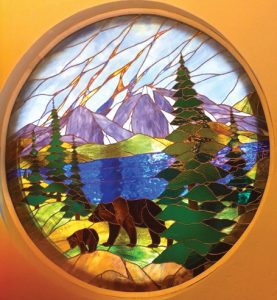
Stained glass artwork by JoAnne Barbiaux Pohler, courtesy photo
“She was [part of] a group of artists that was not afraid to experiment,” says North Lake Tahoe-based glass artist Tom Carter, who took a class from Pohler in 2012. “It’s kind of like jazz and blues in New Orleans.”
Interestingly, Pohler got into stained glass practically by accident. In 1977 she moved from Los Angeles to Truckee and eventually started working at a custom door shop as a bookkeeper. When the company needed stained glass and sandblasting work done, Pohler, who had an art background and had taken a stained glass class previously, stepped up.
“It sort of just fell into my lap. But then I really enjoyed it,” she says. “At the time, it was kind of evolving, and it was a really good time to get into stained glass.”
Pohler enjoyed a long and distinguished career making stained glass, despite styles and trends not always following her along the way.
“I think it’s cooled down a little, because houses are a little more contemporary,” Pohler says. “I actually did a couple jobs in Reno before I retired, and you can make it work in a contemporary setting. Some people have a fixed idea of what stained glass is.”
From Middle Ages to Modern Homes
It’s true. When most people think of stained glass, they picture large biblical-themed or geometric windows in churches and cathedrals, which stand out as some of the most dramatic examples of the art form.
Among the world’s most renowned buildings featuring elaborate stained glass are the Sainte-Chapelle in Paris, France (commissioned by King Louis IX in the thirteenth century), La Sagrada Familia in Barcelona, Spain, King’s College Chapel in Cambridge, England, and Aachen Cathedral in Germany, to name just a few.
Archeological finds date colored glass back to ancient Egypt and Rome in the form of glass beads, while stained glass windows in Britain have been traced back to the seventh century.
But stained glass, as most of us know it, found prominence during the latter part of the Middle Ages, when artists used large, brightly colored glass to illustrate biblical stories or to simply provide divine light in special places of worship.
France’s Chartres Cathedral is considered one of the most stunning and important religious structures in Europe. It’s the definitive example of Classic, or High Gothic, architecture, and most of its stained glass windows remain intact. In the United States, St. Michael’s Church in New York and the Tiffany dome in the Chicago Cultural Center—one of the largest stained glass domes in the world, measuring 38 feet in diameter and containing 30,000 pieces of glass—are examples of awe-inspiring and innovative uses of stained glass.
Of course, through the centuries, stained glass has made its way from the most grandiose cathedral windows into people’s homes. It’s also been incorporated into other architectural designs and used for decorative sculptures and light fixtures.
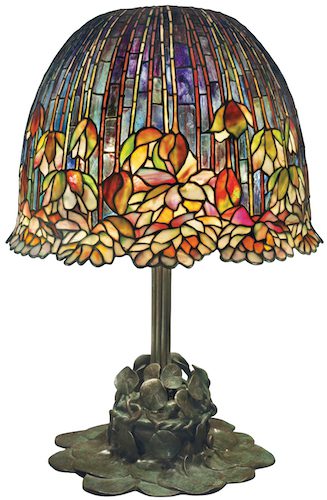
Designed in 1893, Tiffany lamps are created using the now-common copper-foil technique, courtesy photo
Technique and the Tiffany
Among the biggest innovations, in both application and technique, came in 1893 when Louis Comfort Tiffany and other artists, including Clara Driscoll, designed the Tiffany lamp.
The lamps were showcased at the World’s Columbian Exhibition in Chicago and were soon in high demand throughout the United States and Europe. Each lamp was hand-crafted and made using the copper-foil technique, sometimes called the Tiffany Technique.
The method allows artists to create detailed and seamless designs, and it works particularly well for smaller projects. Artists apply copper tape to the edges of each glass piece and then solder them together. Essentially, it’s the gold standard, and is still used by most stained glass artists today.
Large-scale window pieces require a different approach known as the leaded-glass technique, which has been used for centuries. Artists fit pieces of glass between lead cames, which results in thick, dark borders between sections. The cames provide support for thinner, larger pieces of colored glass.
The most important piece to a brightly colored window is the glass itself. Stained glass is typically made using silica sand, which provides strength and clarity. It comes in various styles and textures. The color comes from adding metal oxides or metal powders to the molten glass.
The type of glass used depends on what an artist is trying to accomplish. Sometimes the intent is to provide light, or to block out light—or perhaps to obscure the view of a parking lot or neighbor.
Tahoe’s Stained Glass ‘Potato Chip’
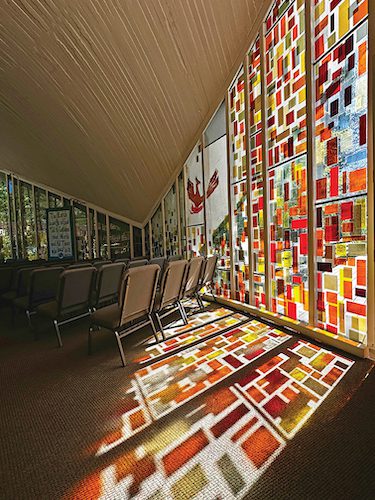
Along with the unique design of the Olympic Valley Chapel, the building features 175 individual panels of stained glass by artist Anne Knorr, photo by Michael Kennedy
While the copper-foil and leaded-glass techniques are most common among stained glass artists, there are other ways to bring colored glass to life. One technique was created right here in Tahoe.
The storied Olympic Valley Chapel was built in 1959 as a non-denominational church for the athletes and visitors of the 1960 Winter Olympics. The structure, designed by John Lipscomb, George Killam and Richard Whitaker, is a sight unto itself, commonly referred to as the “potato chip” for its resemblance to a Pringle.
The treasured landmark is a striking innovation in design, right down to the stained glass work by artist Anne Knorr. The windows, which rise from the floor all the way up to the building’s signature roof, occupy three sides, and were constructed using 175 individual panels.
The real feat was how they were assembled. Rather than using the leaded-glass technique, which is quite expensive for a project of this scale, Knorr used a clear epoxy-resin adhesive to bond the 9,000 (or so) individual pieces of glass together. In addition to being more cost-effective, the bond technique gave Knorr far more artistic freedom.
Credit must also be given to Paul and Alice Arthur, who’ve been with the church since day one. Both have been hugely important in maintaining the structure and the glass, which over the years has fallen prey to the elements, vandalism and a fire in 1994. Paul, a designer and builder, is also responsible for the addition of a patio deck and sanctuary at the rear of the church.
Carrying on an Ancient Art
As with Pohler and the Arthurs, stained glass artist Marjorie Voorhees has done her part to keep the art form alive.
Voorhees is one of 12 children, born and raised in Sierra Valley north of Tahoe. As a young girl she was fascinated by the colored glass used in bottles, and in 1990 she took a class on stained glass making. By that point she already knew how to solder from her years doing sheet metal work.
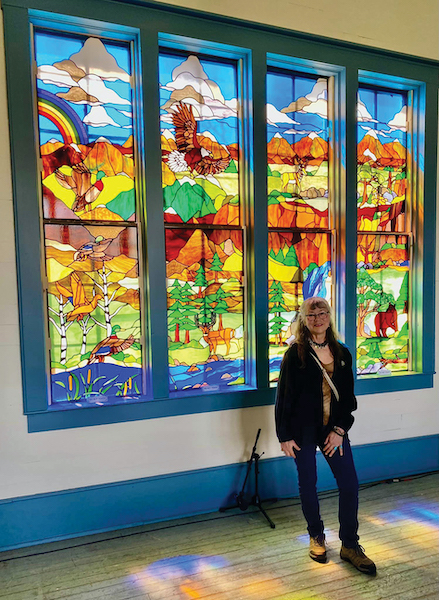
Marjorie Voorhees stands in front of Headwaters, a stained glass artwork she created for the historic Old School House in Loyalton. The piece measures 8 feet by 8 feet and includes 1,400 individual pieces spanning eight panels, courtesy photo
She says cutting glass and creating artwork came naturally, and for that she credits her father, who was a prominent member of the Northern Paiutes (her sister is also an artist, known for her decorative hand-weaved baskets inspired by their family’s tribal roots).
Voorhees opened Country Class Collectibles at the Sattley Cash Store in 2014, specializing in smaller art pieces, but she’s done several larger projects, too, including the windows of a Catholic church in Sierra City. Her work was also on display in September during the Sierra Valley Art + Ag Trail event, for which Voorhees and other artists created stained glass barn squares, or barn quilts.
“I think a lot more people have the desire to learn how to [make] glass because they’ve seen what I produce,” says Voorhees, who also enjoys teaching and working with younger artists.
Earlier this year Voorhees made her most personally satisfying piece, called Headwaters. Installed in the historic Old School House in Loyalton, the artwork measures 8 feet by 8 feet and is composed of 1,400 individual pieces spanning eight panels, which together create a stunning scene of wildlife and mountains complete with a rainbow and waterfall.
“When I went in there and saw that for the first time, it brought tears to my eyes,” Voorhees says. “It was hard to believe I did that.”
Voorhees has seen stained glass artists, and even many of the big glass manufacturers, call it a day. Yet she still sees a bright future for the art form.
“[Stained glass] is at a plateau right now,” she says. “We could go any direction. In our local area, I’m getting a lot of requests for commissions. I think we’re ready for a revival.”
Mark Lore is a Portland-based journalist, DJ and musician. He loves his wife and kids, his community and his vinyl records.




No Comments